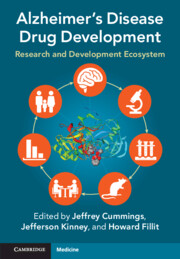Book contents
- Alzheimer’s Disease Drug Development
- Alzheimer’s Disease Drug Development
- Copyright page
- Dedication
- Contents
- Contributors
- Foreword
- Acknowledgments
- Section 1 Advancing Alzheimer’s Disease Therapies in a Collaborative Science Ecosystem
- 1 Alzheimer’s Disease Drug Development: A Research and Development Ecosystem
- 2 Drug Development for Alzheimer’s Disease: An Historical Perspective
- 3 Alzheimer’s Disease Drug Discovery in Academia: From High-Throughput Screening to In Vivo Testing
- 4 The Harrington Discovery Institute and Alzheimer’s Disease Drug Development
- 5 Repurposed Agents in Alzheimer’s Disease Drug Development
- 6 Artificial Intelligence in Alzheimer’s Drug Discovery
- Section 2 Non-clinical Assessment of Alzheimer’s Disease Candidate Drugs
- Section 3 Alzheimer’s Disease Clinical Trials
- Section 4 Imaging and Biomarker Development in Alzheimer’s Disease Drug Discovery
- Section 5 Academic Drug-Development Programs
- Section 6 Public–Private Partnerships in Alzheimer’s Disease Drug Development
- Section 7 Funding and Financing Alzheimer’s Disease Drug Development
- Index
- References
3 - Alzheimer’s Disease Drug Discovery in Academia: From High-Throughput Screening to In Vivo Testing
from Section 1 - Advancing Alzheimer’s Disease Therapies in a Collaborative Science Ecosystem
Published online by Cambridge University Press: 03 March 2022
- Alzheimer’s Disease Drug Development
- Alzheimer’s Disease Drug Development
- Copyright page
- Dedication
- Contents
- Contributors
- Foreword
- Acknowledgments
- Section 1 Advancing Alzheimer’s Disease Therapies in a Collaborative Science Ecosystem
- 1 Alzheimer’s Disease Drug Development: A Research and Development Ecosystem
- 2 Drug Development for Alzheimer’s Disease: An Historical Perspective
- 3 Alzheimer’s Disease Drug Discovery in Academia: From High-Throughput Screening to In Vivo Testing
- 4 The Harrington Discovery Institute and Alzheimer’s Disease Drug Development
- 5 Repurposed Agents in Alzheimer’s Disease Drug Development
- 6 Artificial Intelligence in Alzheimer’s Drug Discovery
- Section 2 Non-clinical Assessment of Alzheimer’s Disease Candidate Drugs
- Section 3 Alzheimer’s Disease Clinical Trials
- Section 4 Imaging and Biomarker Development in Alzheimer’s Disease Drug Discovery
- Section 5 Academic Drug-Development Programs
- Section 6 Public–Private Partnerships in Alzheimer’s Disease Drug Development
- Section 7 Funding and Financing Alzheimer’s Disease Drug Development
- Index
- References
Summary
There is a tremendous need for disease-modifying treatments for Alzheimer’s disease (AD). The pharmaceutical sector has expended considerable resources on AD drug discovery, yet to date have obtained regulatory approval for only one agent that slows AD progression. This has led to increased interest in identifying new AD drug targets and disease mechanisms. Academic laboratories can play a meaningful role in the validation of AD drug targets and the identification of molecular probes that modulate these targets. We discuss here how academic researchers can contribute to the AD drug discovery process. This includes examples of assays that have been used for AD small molecule screens within academic laboratories, and discussions on assay optimization for compound screening, the selection of molecular libraries, and the iterative process of compound optimization to identify molecules suitable for advancement to in vivo pharmacokinetic, safety, and efficacy testing. Finally, we outline how academic researchers might work with pharmaceutical partners in AD drug discovery, and note the pros and cons of such collaborations.
Keywords
- Type
- Chapter
- Information
- Alzheimer's Disease Drug DevelopmentResearch and Development Ecosystem, pp. 34 - 44Publisher: Cambridge University PressPrint publication year: 2022

